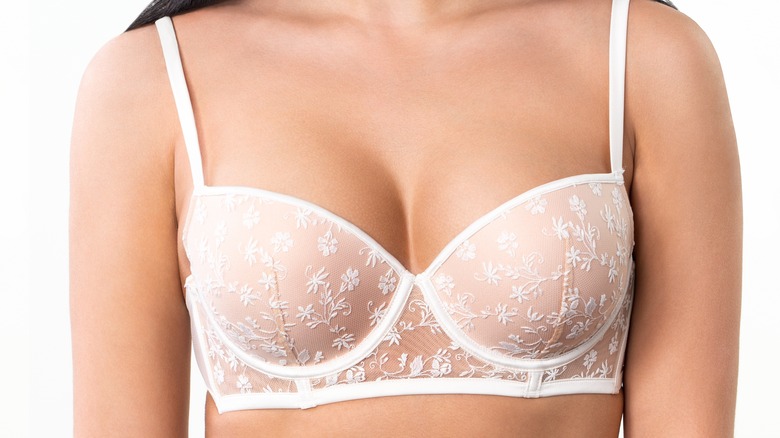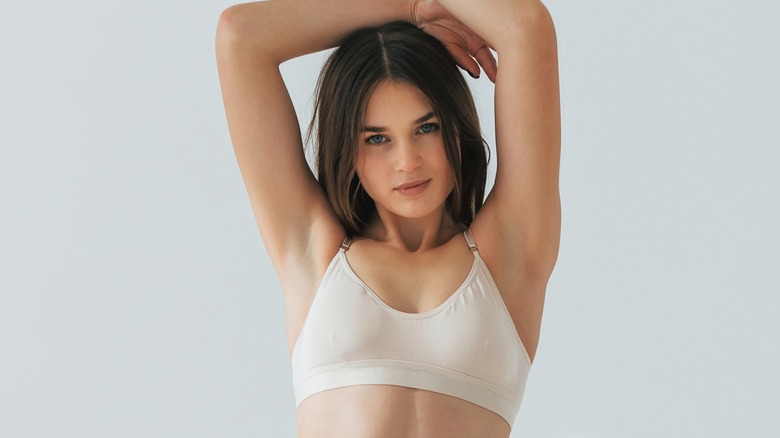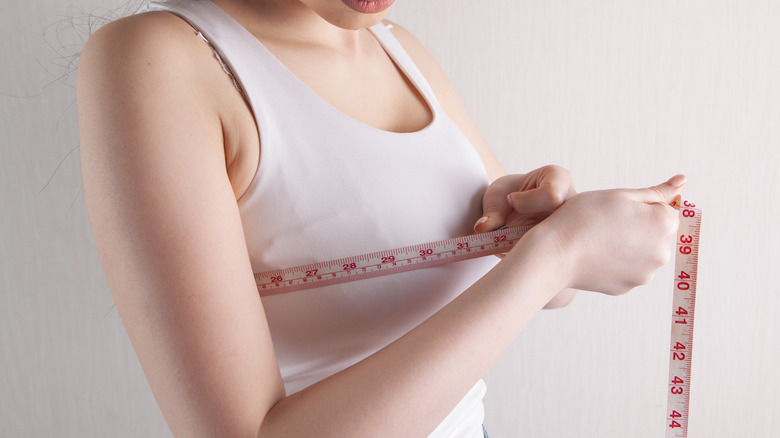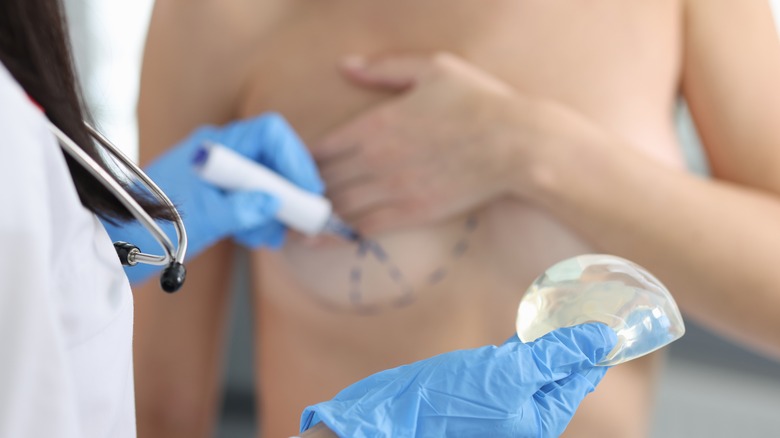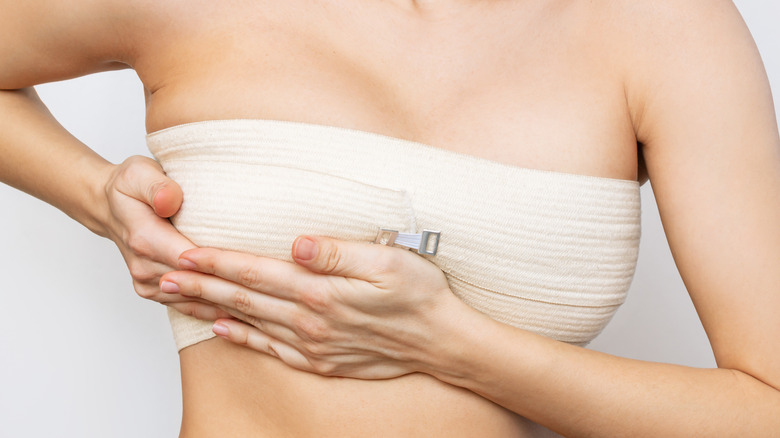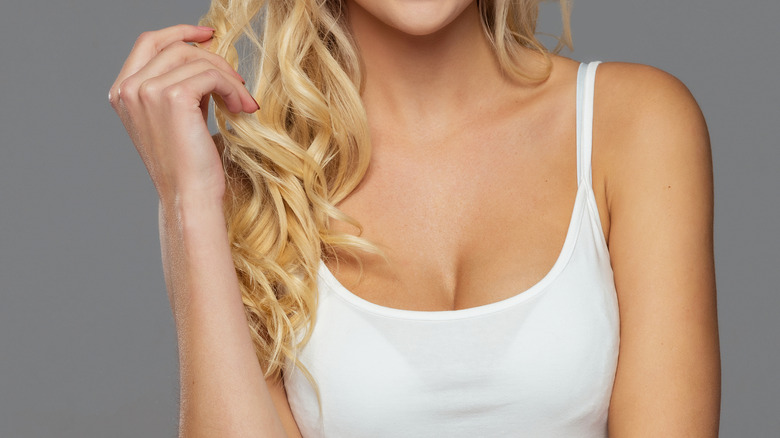What You Need To Know About Vampire Breast Lifts
First things first, a woman's femininity is not determined by whether she has breasts or how big her breasts are. However, since full breasts are traditionally linked to womanhood, many consider the shortcomings of their breasts a decrease in sexual desirability and self-worth. That's why most women start putting a premium on breast care — for both health and aesthetics purposes — at a very young age. Nonetheless, breasts will naturally become saggy over time as a result of things like age and breastfeeding. Once breasts start to lose elasticity naturally, no amount of diet or topical treatment can fully restore them to their former glory. This is where breast lift surgeries can come into play.
Data from The Aesthetic Plastic Surgery statistics show that U.S. consumers spent over $14.6 billion dollars on aesthetic procedures in 2021, with breast surgeries increasing by 48%. Per the Cleveland Clinic, there are plenty of methods that help women attain the breasts they desire, but they mostly fall under the umbrella of two basic forms of breast augmentation: breast implants and fat transfer augmentation. Because breast augmentation is a major surgery filled with potential hazards and complications, it's not for everyone. For those who are not ready to go under the knife, a non-invasive procedure known as the Vampire Breast Lift (VBL) might be of interest. Here's everything you need to know about the VBL, a procedure that improves your breast shape sans surgery.
A Vampire Breast Lift is not a breast augmentation
The VBL — also known as platelet-rich plasma (PRP) breast lift — is a non-invasive procedure that enhances the outward appearance of your bust and cleavage area using your own blood cells. According to the Cleveland Clinic, this procedure doesn't require major surgery or much downtime. During this procedure, a healthcare professional injects platelet-rich plasma, which is obtained from your blood and responsible for blood clotting and cell reproduction, into the areas that need treating. The intended outcome is a fuller bust with improved skin texture.
A VBL is said to stimulate new cell growth, diminish stretch marks and wrinkles, promote collagen production, and increase elastin — a protein that's crucial for the skin's elasticity. Seiler Skin notes that VBL is by no means a breast augmentation, meaning it cannot take your cup size up a notch like traditional surgeries. It can only improve the aesthetic appearance of your breasts and nipples, including repairing damaged or thinning skin resulting from any previous implants and improving nipple sensitivity or inversion. Therefore, if your wish is to increase breast size, you might have to check out other options.
Who qualifies for Vampire Breast Lifts?
The ideal candidates for the VBL are those who are content with their breast size and are interested in making their cleavage area look firmer and more pronounced, per PRP Aesthetic. A woman's breast skin might get more crepey as she ages, and what she needs is a reduction of excess skin and some tightening in the area. A VBL works much like a push-up bra, making your breasts look perkier in addition to slowing the signs of aging on your chest.
According to RejuvenationMD, a VBL treatment will start with a consultation with a plastic surgeon to discuss your expectations, medical conditions, and lifestyle habits. If your goal is to increase cup size, your healthcare professional might refer you to other surgical options that will create the results you desire. As with other cosmetic procedures, smoking or vaping — which delays healing and increases risks of infection — is a big no-no for those planning for breast lift or breast augmentation. If you undergo a VBL, you might be asked to quit smoking for a period of time.
Vampire Breast Lift results are not permanent
As previously mentioned, a VBL involves extracting the platelets from your blood and reinjecting them back into your body. Because nothing foreign is entering your body, it's generally considered a safe procedure as long as you are working with an experienced, board-certified doctor (via RealSelf).
A VBL costs anywhere between $1,500 to $2,000 — a fraction of the average cost of surgical breast augmentation, and it is not covered by insurance. In contrast to a traditional breast lift — which typically requires about two weeks of recovery time — a VBL requires minimal downtime. Results start to show almost immediately after the procedure with full results occurring within a few months. Although it's a fairly simple procedure, VBL results are temporary and typically last up to two years. However, this may vary from person to person, depending on how their bodies respond to PRP. To maintain the results, you need to follow up with another injection every year or so.
What happens during a Vampire Breast Lift?
A typical VBL treatment lasts 90 minutes, and you can go home or get back to work soon after the procedure. According to Glow Laser and Beauty Center, the treatment starts with a healthcare professional inserting a needle into your arm to draw your blood. During the process, your doctor will use a centrifuge — a device that spins the blood to separate platelets and plasma from other red blood cells. Next, platelet-rich plasma (PRP) — a solution containing plasma and platelets — is re-injected into the breasts through multiple injections.
The crux of the VBL treatment, the introduction of PRP into the body, helps to stimulate collagen and elastin production, which can tighten and plump up sagging skin, per Artisan Aesthetic Clinics. Due to its collagen-boosting capacity, PRP is also excellent for enhancing the general texture and tone of the skin and can also be beneficial for those with acne or rosacea.
Can a VBL be used in conjunction with other procedures?
According to Procerus Skin Care, depending on your expectations and health conditions, another treatment might be suggested in conjunction with VBL to maximize results. For instance, a plastic surgeon might recommend VBL with other procedures such as CO2 laser skin resurfacing, microneedling, or Ultherapy.
Much like Vampire Breast Lifts, Ultherapy is a great FDA-approved option for those looking to lift their breasts without surgical intervention. In Ultherapy, waves of heat are delivered deep into the skin through highly concentrated ultrasound radiation to heat the skin tissue and stimulate the production of collagen and elastin, Renove Med Spa explains. The results are tightened skin and significant improvement of fine lines and wrinkles. CO2 laser resurfacing — a non-invasive procedure that employs a laser to eliminate the outer layers of damaged skin — can also tighten the loose skin and reduce stretch marks to give the cleavage area a more pronounced appearance, per Healthline.
Vampire Breast Lifts post-op care
Since there are no major incisions during VBL, there won't be any major activity or diet restrictions following the procedure. Bruising and swelling — which typically resolve in a few days — are reportedly the only immediate effects associated with the treatment. Naturopathic physician Dr. Emina Jasarevic recommends drinking lots of water after the procedure. The blood draw might make you feel dizzy, so you might want to eat a light meal before your treatment as well.
To avoid interfering with your results, plastic surgeon Dr. Ellen Mahony recommends washing the treated area gently using mild soap or any irritant-free alternative and avoiding alcohol use and high-impact exercise for one full day. You also need to refrain from rubbing or massaging your breasts at least until all the redness and swelling have subsided, and alter your sleeping positions to avoid putting pressure on your chest. If your breasts feel sore, you can apply a cold compress on the treated area for 15 minutes a few times per day.
Side effects and complications of Vampire Breast Lifts
Since VBL is a simple cosmetic procedure, its side effects are minimal and complications are rare. As OB-GYN and doctor of osteopathic medicine, Dr. Monica Grover explained to POPSUGAR, "There are no risks of foreign-body rejection because the body recognizes the growth factors as its own, nor [risks of] any type of scar tissue or encapsulation." Rarely, however, pneumothorax may occur which is a condition in which the lungs collapse as a result of an abnormal accumulation of air in the gap between the lung and the chest wall. The more common side effects following a VBL are inflammation and soreness, both of which should subside in a day or two.
As far as pain is concerned, a VBL doesn't exactly tickle. While the injections can be painful when done without any additional pain management, providers typically will offer options like laughing gas, numbing cream, and lidocaine to help take the edge off.

